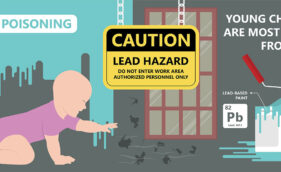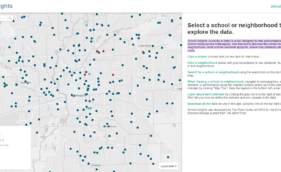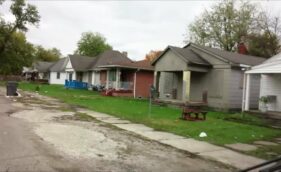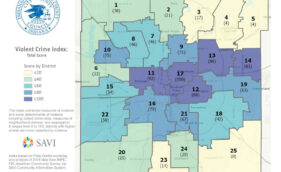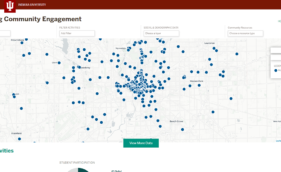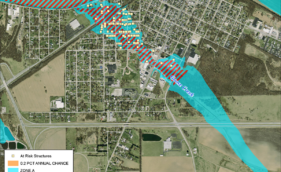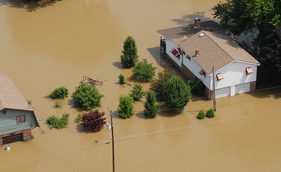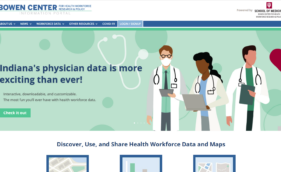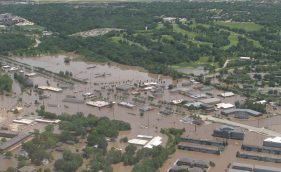More Projects
09/08/2023
Jump IN for Healthy Kids
The Indiana Department of Health funded a collaborative proposal from Polis and Jump IN for Healthy Kids to develop a public-facing community dashboard to distribute information about the community impact of childhood obesity. Jump IN is a multi-sector initiative targeting childhood obesity that “leads the strategy and implementation to make sustainable improvements at a systems level,…
09/01/2023
potential geological sequestration in Indiana
The U.S. Department of Energy, Office of Fossil Energy and Carbon Management recently announced an investment in State Geological Surveys to study the potential for carbon sequestration in their respective state. The Indiana Geological and Water Survey (IGWS) is one of the selected projects. Working with IU’s Center for Rural Engagement, Polis, and DRB Geological…
08/23/2023
Quantifying the effects of lead exposure on children’s futures
At the August 24 Data & Drafts event, cosponsored by IndyPL, WFYI Public Media, and Bier Brewery, we presented findings from our analysis of the state of childhood blood levels in Marion County. We looked at childhood lead exposure in Marion County, its impacts, and what can be done, with a particular focus on the…
03/08/2023
How is Indianapolis Doing?
Our initiative, How is Indianapolis Doing, describes the city’s economic recovery since the COVID-19 pandemic. Highlights as of August 28 include Indianapolis unemployment rate increasing from 2.6% in April to 3.6% in June (nationwide increase from 3.4% to 3.7%); housing prices in the Indianapolis metro area declined in July 2022 for the first time in nearly…
02/16/2023
Polis Center collaborating on iHEART initiative aimed at reducing health inequities contributing to cardiovascular health
The Polis Center is working with Indiana University Health, the Indiana Clinical and Translational Science Institutes, and the Fairbanks School of Public Health in collaboration with Novartis Pharmaceuticals Corporation as part of a three-year initiative to create the Indianapolis Health Equity, Access, outReach and Treatment (iHEART) collaborative aimed at reducing health inequities that contribute to…
08/31/2022
Martin University Market Analysis
In an environment of increasing competition and decreasing college enrollment, Martin University needed to be strategic about attracting new students. Polis developed a market analysis to discover target areas throughout Indianapolis that matched Martin University’s marketing and enrollment goals, then analyzed those areas to provide actionable information recruiters can use.
08/31/2022
Fox Cities, Wisconsin
Fox Cities United Way in Wisconsin tracks community indicators in their LIFE Study. Polis developed, analyzed, and published these indicators, as well as produced a well-documented, routine data processing system.
08/31/2022
INHP Evaluation Report
When Indianapolis Neighborhood Housing Partnership received a $50 million grant to improve access to homeownership, they needed a way to evaluate their impact. Polis partnered with IU Public Policy Institute to develop a comprehensive evaluation of their programs. This included quantitative metrics about the people and places they served, as well as qualitative data from…
08/31/2022
School Insights
Indianapolis has one of the most diverse school choice landscapes in the country. This makes it difficult to evaluate the need for school capacity in neighborhoods. Using data from Indianapolis’ unified enrollment system, Polis built a web app designed to help policymakers better understand school trends across Indianapolis. It shows school demand, quality, and demographics…
04/15/2022
SAVI Changing Landscape of Poverty
In June 2019, SAVI released a report documenting the Changing Landscape in Poverty in Central Indiana. It revealed an increase in poverty in older suburban neighborhoods of Indianapolis, especially in places like the Far Eastside. But it only scratched the surface in understanding poverty, its impacts, and what can be done; and organizations need support…
04/15/2022
Great Families 2020/Social Innovation Fund
This four-year United Way of Central Indiana (UWCI) program, funded with federal assistance via the Social Innovation Fund (SIF), aimed to improve financial stability among families in Indianapolis by using a two-generational approach to service delivery. The initiative focused on strengthening families in targeted communities by following Aspen Institute’s two-generation model. Polis partnered with the…
03/16/2022
Measuring Human Social and Environmental Indicators
Not all patients follow their health providers’ treatment recommendations, to their detriment, but they may be doing the best they can under circumstances. Some people live and work in environments that work against efforts to improve health. Care and treatment of patients is expected to be more successful when the patient’s environment is considered as…
04/30/2021
Council District Crime Prevention Grant program
Polis built a new partnership to support policymaking in Central Indiana with a collaboration with the Indianapolis City County Council to develop actionable data to inform its public safety grant allocation process and to inform its committee on race and equity about the inequities Black Indy residents face in the current pandemic that contribute to…
04/11/2021
IU Indianapolis Community Engagement Map
We developed an online Community Engagement Map leveraging SAVI, in partnership with the IU Indianapolis Office of Community Engagement (OCE). We linked data from SAVI and IU Indianapolis Collaboratory (a database of in-depth information entered by students, faculty and staff about ways they are engaged with the community.) to continually update an online searchable map…
12/21/2020
Hydraulic Assessment of Mitigating Flooding Impact
The City of Logansport endured recurring flooding issues, with the greatest concern being the concentration of structures within the flood boundary along Goose Creek. After engaging with community officials, it was determined that focusing efforts on Goose Creek would provide the greatest mitigation impact for the city. The current effective flood boundaries along Goose Creek…
03/04/2020
Decision Support Systems: Indiana Flood Mitigation Platform
Flood mitigation planning in Indiana and many other states results in the creation or update of a hard copy plan that often sits on a shelf. However, the flood mitigation strategies contained in the plans, as well as the GIS data used to support analysis for the plan, are too important to be stored in…
03/04/2020
Transportation Vulnerability Assessment: Owen County, IN
Owen County and the Towns of Spencer and Gosport in the State of Indiana experienced multiple instance of severe flooding, which negatively impacted transportation and disrupted the flow of community life. The majority of flood damages occurred along the West Fork White River, the White River, and several tributaries. The Polis Center assisted the Indiana Department…
03/04/2019
Developing an Integrated Data Portal to Manage Data: Bowen Center for Health Workforce Research & Policy
The Bowen Center for Health Workforce Research & Policy at the IU School of Medicine, Department of Family Medicine, is engaged in research to inform health policy, improve health care delivery and promote population health. A large portion of Bowen Center’s current research focuses on the health workforce and the influence of various health care…
12/11/2017
IndyVitals: Increasing Transparency and Coordination through Better Data Access
The IndyVitals tool was conceived as a means to measure the long-term health and sustainability of neighborhoods. A second goal was to help organizations by making comparative neighborhood-level data transparent. The true power of IndyVitals is its ability to coordinate actions of community partners by highlighting the strengths and challenges of diverse neighborhoods in Indianapolis. As data can be very complex, IndyVitals offers…
03/04/2017
Natural Hazard Mitigation Saves: 2017 Interim Report
The National Institute of Building Sciences (NIBS) Multihazard Mitigation Council (MMC) wanted to update and expand its landmark 2005 Mitigation Saves Study to incorporate new science, data and other important considerations in the decade following that study. Toward that end, NIBS developed a team of dozens of experts in multiple disciplines including engineering, earth science, economics,…




